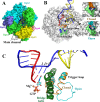Computational simulation strategies for analysis of multisubunit RNA polymerases
- PMID: 23987500
- PMCID: PMC3829680
- DOI: 10.1021/cr400046x
Computational simulation strategies for analysis of multisubunit RNA polymerases
Figures






References
Publication types
MeSH terms
Substances
Grants and funding
LinkOut - more resources
Full Text Sources
Other Literature Sources

